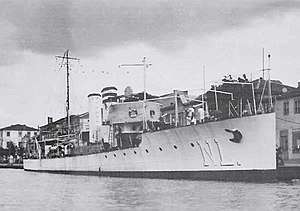NMS Năluca
 | |
| History | |
|---|---|
| Name: | Tb 82 F |
| Builder: | Ganz & Danubius |
| Laid down: | 1913 |
| Launched: | 1914 |
| Commissioned: | 1916 |
| Fate: | Given to Romania as reparations, 1920 |
| Name: | Năluca |
| Namesake: | The Romanian word for ghost |
| Commissioned: | 1920 |
| Fate: | Sunk by Soviet aircraft, 20 August 1944 |
| General characteristics | |
| Class and type: | 250t-class torpedo boat |
| Displacement: |
|
| Length: | 58.5 m (191 ft 11 in) |
| Beam: | 5.8 m (19 ft 0 in) |
| Draft: | 1.5 m (4 ft 11 in) |
| Propulsion: | 2 Yarrow boilers, 2 AEG turbines, 2 shafts, 5,000 horse power |
| Speed: | 28 knots (52 km/h) |
| Range: | 1,200 nautical miles (2,200 km) |
| Complement: | 38 |
| Armament: | |
NMS Năluca was a torpedo boat of the Royal Romanian Navy. She was commissioned in 1920, after initially serving as Tb 82 F in the Austro-Hungarian Navy during World War I. She and six more sister ships were awarded to Romania as reparations after the war ended.
Construction and specifications
A vessel of the F-group of the 250t-class, Năluca was built by Ganz & Danubius at Fiume and nearby Porto Re, along with the rest of her group, between October 1913 and December 1916. Under the designation 82 F, she was laid down in 1913, launched in 1914 and completed in 1916. She had a waterline length of 58.5 m (191 ft 11 in), a beam of 5.8 m (19 ft 0 in), and a normal draught of 1.5 m (4 ft 11 in). While her designed displacement was 266 tonnes (262 long tons), she displaced about 330 tonnes (320 long tons) fully loaded. The crew consisted of 38 officers and enlisted men. Her AEG-Curtiss turbines were rated at 5,000 shp (3,700 kW) with a maximum output of 6,000 shp (4,500 kW), enabling her to reach a top speed of 28 knots (52 km/h; 32 mph). She carried 20 long tons (20.3 t) of coal and 34 long tons (34.5 t) of fuel oil,[1] which gave her a range of 1,200 nmi (2,200 km; 1,400 mi) at 16 knots (30 km/h; 18 mph). Under the provisions of the Treaty of Saint-Germain-en-Laye, she was given as reparations to Romania in 1920, along with six more boats of the same class.[2][3] During World War II, she had no torpedo tubes.[4] These were replaced by depth charges, her artillery consisting of two 66 mm naval guns and two 20 mm anti-aircraft guns.[5] The depth charges were deployed using one 400 mm thrower.[6]
Career
While fighting on the Axis side during World War II, she was involved in the minelaying operation of the Bulgarian coast in October 1941.[7]
On 9 July 1941, Năluca, aided by the motor torpedo boats Viscolul and Vijelia, sank the Soviet Shchuka-class submarine Shch-206 near Mangalia.[8][9][10][11]
On 28 September 1942, Năluca was unsuccessfully attacked by the Soviet M-class submarine M-120 near the Southern coast of the Crimea.[12]
Between 26 July and 17 September 1943, Năluca carried out 12 escort missions, between Constanța and Odessa. On 27 August, during the 8th escort, her convoy was unsuccessfully attacked by seven Soviet torpedo bombers.[13]
See also
Sources
- ↑ Jane's Information Group 1989, p. 313.
- ↑ René Greger, Austro-Hungarian Warships of World War I, London, England: Ian Allan, 1976, pp. 58 and 60
- ↑ Jane's Information Group, Jane's Fighting Ships of World War II, London, England: Studio Editions, 1989, p. 313
- ↑ Antony Preston, Warship 2001-2002, Conway Maritime Press, 2001, p. 70
- ↑ Janusz Piekałkiewicz, Sea War, 1939-1945, Historical Times, 1987, p. 350
- ↑ Е. Е. Шведе, Военные флоты 1939—1940 гг., Рипол Классик, 2013, p. 119 (in Russian)
- ↑ Donald A Bertke, Gordon Smith, Don Kindell, World War II Sea War, Volume 4: Germany Sends Russia to the Allies, p. 323
- ↑ Antony Preston, Warship 2001-2002, Conway Maritime Press, 2001, p. 72
- ↑ Cristian Crăciunoiu, Romanian navy torpedo boats, Modelism, 2003, p. 135
- ↑ Donald A Bertke, Gordon Smith, Don Kindell, World War II Sea War, Volume 4: Germany Sends Russia to the Allies, Bertke Publications, 2012, p. 134
- ↑ Jipa Rotaru, Ioan Damaschin, Glorie și dramă: Marina Regală Română, 1940-1945, Ion Cristoiu Publishing, 2000, pp. 50-51
- ↑ Donald A Bertke, Gordon Smith, Don Kindell, World War II Sea War, Vol 7: The Allies Strike Back, Bertke Publications, 2014, p. 71
- ↑ Jipa Rotaru, Ioan Damaschin, Glorie și dramă: Marina Regală Română, 1940-1945, Ion Cristoiu Publishing, 2000, pp. 267-268